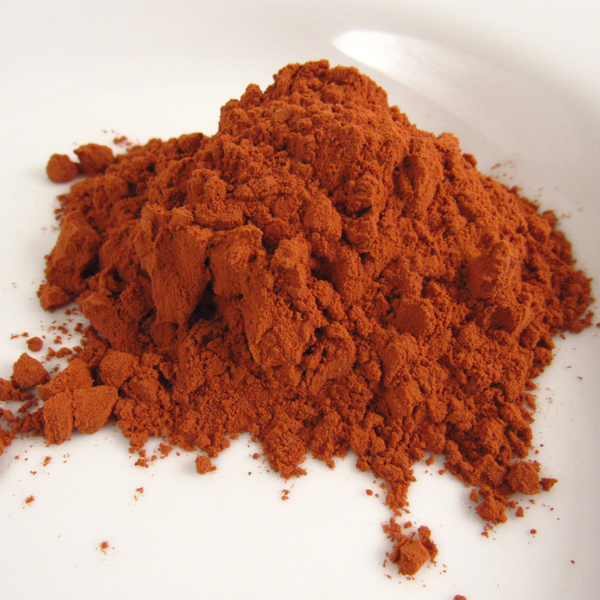
Today in our tannin series we move on to Quebracho Moreno. Quebracho (Schinopsis balansae and Schinopsis lorentzii) is an evergreen tree that grows wild in South America. It grows mainly in Argentina and Paraguay in dense sub-tropical forests which also include a variety of other trees and vegetation. The name is due to its hardness, and comes from two Spanish words, quebrar and hacha, meaning “axe breaker”. In fact, quebracho has been used locally for posts, telegraph poles, bridge timbers, railway ties, paving blocks and for any construction where great durability is desired.
Quebracho Moreno (we used to carry a Quebracho Rojo, so we called this one Moreno) is high in tannin. It can be used as a tannin mordant or a dye on cellulose fibers. The extract will produce a golden beige color and will darken slightly on exposure to direct sunlight. For more information on using it as a dye, please see our page on natural dye extracts.
When combined with other colors you can get exciting mixes and beautiful color blends that harmonize and are perfect for patchwork, creating gradations and stitching.
Skill level: Good for an intermediate or advanced dyer. You should be familiar with cellulose mordanting, using iron as a post-bath, dyeing with natural dye extracts, and indigo dipping. If you are an adventurous beginner, try quebracho + indigo and as your skills develop, move to the other variations.
The inspiration for using Quebracho comes from Sara Buscaglia of Ancient Futures Farm and author of the book Farm & Folk Quilt Alchemy (we have signed copies!) In her book, Sara beautifully articulated some ideas that I’d been mulling over and when I saw the results she achieved, I knew we should dive in and start testing colors. It’s been a lot of fun!
Here are some ideas to get you started. We are dyeing with a variation of the traditional tannin-alum cellulose mordant recipe, but have replaced the tannin source with quebracho. Quebracho adds a warm beige base to the palette and surprising shades develop when we use it with indigo. As pop of color, we also show a madder over dye (no indigo) that really completes the palette.
Quebracho Blues – the basic sequence

Pictured here are overdyed Quebracho moreno samples with Indigo. The beige is QM on its own.
Start with 4 pieces of cotton, each approximately the size of a fat quarter (18×22 inches)
Scour cotton fabric, using our scour recipe
Then follow our tannin-alum mordant recipe using Quebracho Moreno in place of Gallo Tannin. Mordant fabric with 10% Quebracho Moreno, and soak for 1 hour. Then create an alum mordant bath with 15% aluminum sulfate or aluminum potassium sulfate and 1.5% soda ash. Soak the fabric in this bath for 1 hour.
Once the fabric has been mordanted, it will be a light beige. At this point, you can over dye it with indigo. A light dip will create a warm, dusty blue. Medium and darker dips will create deeper blues, always with a warm undertone.
Quebracho Blues with Iron – the basic sequence

Pictured here are from left to right: Quebracho with iron and light indigo, quebracho with iron and dark indigo, quebracho with iron on its own, and quebracho alone.
Start with 5 pieces of cotton, each approximately the size of a fat quarter (18×22 inches). Mordant with Quebracho and aluminum sulfate + soda ash as above.
Another variation using Quebracho is to use Iron (Ferrous Sulfate) as a post-dip. The iron shifts Quebracho from yellow-brown to a darker tree bark shade. When the iron-modified color is dipped into indigo using light, medium and dark dips, a whole new palette is created and it is beautiful.
Quebracho Greens with Weld – the basic sequence

Pictured here from left to right is: Quebracho with weld and dark indigo, quebracho with weld and medium indigo, quebracho with weld and light indigo, quebracho with weld, and quebracho alone.
Quebracho serves as a solid base for dyeing a rich yellow using weld extract @3%, and then dipping the Quebracho-weld fabrics in a light, medium and dark indigo vat.
Start with 5 fat quarters, or 6 if you also want to over dye with madder as below.
Quebracho with Weld & Madder

We also over dyed the weld shade with a madder exhaust bath and got a very nice coral that really added a pop of color to the palette. If you are making a fresh bath, use about 0.5% madder extract for this shade. The madder sample does not have indigo on it, so dye it with madder right after the weld step.
Notes:
- All of these colors were mordanted and dyed, with indigo being the last step in the process. This is the reverse of what we normally do in our studio but it makes for some beautiful colors! You can try either sequence to see if one method works better for you.
- Rinse fabrics after mordant, iron post-dip or weld dyeing and before dipping into indigo.
- Rinse after the final indigo dip and air dry away from direct sunlight.
- We always dip our indigo at least twice, and use vats that are light, medium or dark strength.
